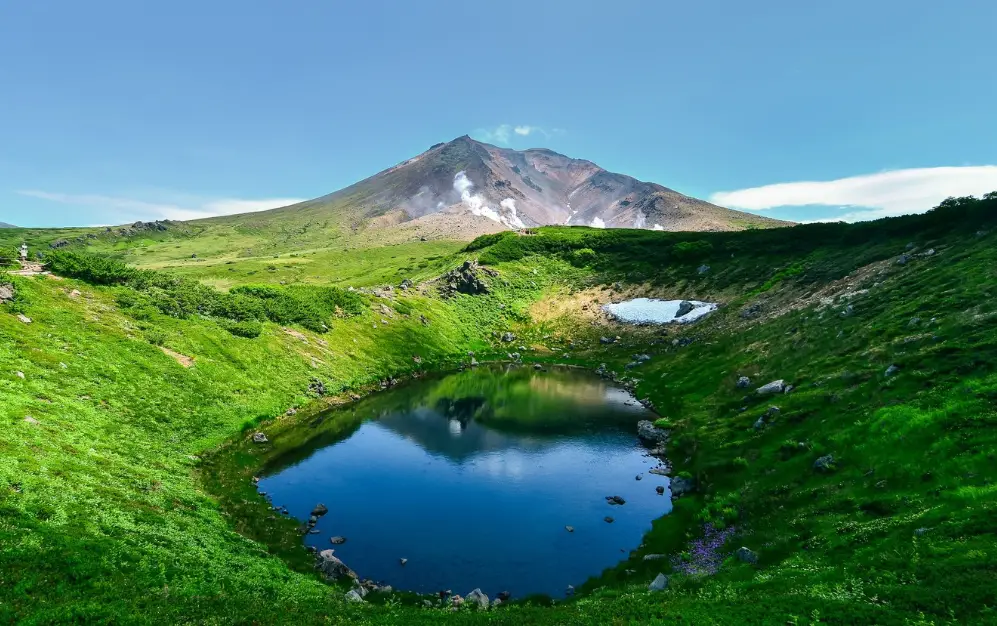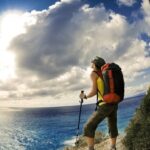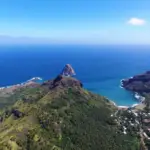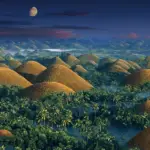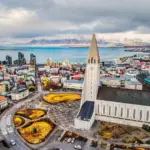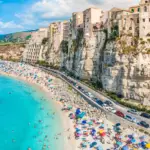
Welcome to this adventure exciting for the Hokkaido Island and by Pacific Ring of Fire! Here, you will discover the wonders of nature and unique culture of this fascinating region. Prepare to be amazed by the natural beauty of this island, such as volcanic landscapes, crystal clear lakes and stunning beaches.
Additionally, we will explore the Pacific Ring of Fire, a region of great volcanic and seismic activity that played an important role in shaping the landscape of Hokkaido Island. You will understand how the natural phenomenon shaped this incredible region.
Main points of this article
- Discover the natural beauty from the Hokkaido Island
- Understand the importance geographic of Pacific Ring of Fire
- Explore the region's natural parks and reserves
- Dive into unique culture of Hokkaido
- Experience exciting outdoor activities

Geographic Location and Importance of the Pacific Ring of Fire
The Island of Hokkaido is one of the most important in Japan and is located in the north of the country. It is the second largest island of the Japanese archipelago, being bathed by the Pacific Ocean to the east and the Sea of Japan to the west. A characteristic unique of the island is its proximity to the Pacific Ring of Fire.
The Pacific Ring of Fire is an area that stretches along the Pacific Ocean, covering approximately 40,000 km. The region has a large number of active volcanoes and is the site of intense seismic activity. Hokkaido It is located in the border zone between the Pacific and Eurasian tectonic plates, making it a highly seismological area.
| Geographical location | Pacific Ring of Fire | Importance |
|---|---|---|
| Hokkaido Island is located in northern Japan, bordering the Pacific Ocean and the Sea of Japan. | The Pacific Ring of Fire is an area stretching along the Pacific Ocean, covering approximately 40,000 km. The region has a large number of active volcanoes and is the site of intense seismic activity. | Hokkaido Island lies on the border between the Pacific and Eurasian tectonic plates, making it a highly seismically sensitive area. However, the region offers an opportunity unique to study volcanic activity and understand the formation of geological terrains. |
Although volcanic and seismic activity can be dangerous, the Pacific Ring of Fire region is a true natural laboratory for scientists and researchers around the world. Studying volcanic activity here can help prevent natural disasters and ensure the safety of populations around the globe. Furthermore, this region offers a stunning natural spectacle, with incredible volcanic landscapes and biodiversity. unique.

Natural beauty of Hokkaido Island
Hokkaido Island is home to an unparalleled wealth of natural beauty that attract visitors from all over the world. In this section, let's go explore some of the natural wonders most impressive on the island, ranging from volcanic landscapes to crystal-clear rivers and stunning beaches.
Mountainous landscapes
One of Hokkaido's most popular attractions is its spectacular mountainous landscapes. The central region of the island is dominated by the Daisetsuzan Mountains, which feature snow-capped peaks and rugged terrain, offering stunning panoramic views. On the island's east coast, you'll find the Shiretoko Mountains, a UNESCO World Heritage Site, offering lush forests and stunning views of the Sea of Okhotsk.
Crystal clear lakes
Hokkaido Island is also famous for its crystal-clear lakes, which offer stunning views and a unique opportunity to experience nature in its purest form. Lake Toya is one of the island's most popular, with its crystal-clear waters and its location near Mount Usu, one of the region's most active volcanoes. Lake Shikotsu, considered one of the clearest lakes in Japan, is surrounded by volcanic mountains, offering a memorable view.
Stunning beaches
If you're looking for stunning beaches and crystal-clear waters, Hokkaido Island is the perfect destination. One of the most famous beaches is Shakotan Beach, known for its impressive rock formations and crystal-clear waters. Another option is Otaru Beach, a tranquil and picturesque spot nestled in a crescent-shaped cove.
Shirahige Falls
Shirahige Falls is one of Hokkaido Island's most impressive natural treasures. Located in Shari City, these cascading waterfalls are a place to relax and admire the natural beauty of the island. At 55 meters high, Shirahige Falls is an unmissable spectacle that is worth the trip.
National parks and nature reserves
Hokkaido Island is a true paradise for nature lovers. With its lush biodiversity, the island is home to a variety of national parks and nature reserves that offer an incredible variety of landscapes and wildlife.

Shiretoko National Park
Shiretoko National Park is a UNESCO World Heritage Site located on the northeastern tip of Hokkaido Island. With its dense forests, crystal-clear rivers, and rugged coastline, the park offers some of the island's most stunning scenery. Here, you can spot animals such as bears, reindeer, and golden eagles.
Akan National Park
Akan National Park is an active volcanic area, famous for its mysterious lakes and natural beautyLake Akan-ko is one of the park's main attractions, with its turquoise waters surrounded by volcanic hills. The park is also home to Mount Meakan, an active volcano, and Mount Oakan, with its challenging trails and incredible views.
| National Parks | Natural Reserves |
|---|---|
| Daisetsuzan National Park | Notsuke Peninsula |
| Rishiri-Rebun-Sarobetsu National Park | Tokachi-dake Natural Reserve |
| Furano-Ashibetsu Nature Park | Shikotsu-Toya National Park |
| Akan Mashu National Park | Kushiro Marshland |
In addition to the national parks, Hokkaido Island also has several nature reserves, which offer a more relaxed way to experience nature. The Notsuke Peninsula, for example, is a nature reserve where you can see migratory birds, seals, and wild horses. The Kushiro Marshland is the largest wetland area in Japan, home to a wide variety of plants and animals.
- Shiretoko National Park is a World Heritage Site
- Akan National Park is an active volcanic area
- Daisetsuzan National Park
- Rishiri-Rebun-Sarobetsu National Park
- Furano-Ashibetsu Nature Park
- Akan Mashu National Park
- Notsuke Peninsula
- Tokachi-dake Natural Reserve
- Shikotsu-Toya National Park
- Kushiro Marshland is the largest marshland in Japan.
“Hokkaido Island is a true treasure trove of biodiversity, with national parks and nature reserves that offer incredible experiences for nature lovers.”
Hokkaido's unique culture
THE culture Hokkaido is truly unique and offers a rich opportunity for learning and inspiration. This region has its own traditions, cuisine, and festivals, reflecting the history and cultural influences of the island. Let's dive into some aspects of culture of Hokkaido that make it so special.
Traditions
THE culture Hokkaido is heavily influenced by the indigenous Ainu, a native people who have lived in the region for over a thousand years. Ainu dance, which involves gentle movements and singing, is one of the island's most iconic artistic expressions. Another cultural tradition of Hokkaido is choral singing, which is passed down from generation to generation and draws applause in local competitions.
Cooking
Hokkaido cuisine is known throughout Japan for its fresh seafood and delicious dairy products. A popular dish is salmon roe sushi, called ikura, which is rich in flavor and much loved by locals. Ramen (noodles cooked in pork broth) and soup curry are also regional specialties.
Festivals
Hokkaido offers a variety of festivals throughout the year, many tied to the seasons. The Sapporo Snow Festival is one of the most famous, where enormous snow sculptures are constructed in the city of Sapporo. The Lavender Flower Festival in Furano, held in summer, is a vibrant event celebrating the beauty of flowers. The Nebuta Fire Festival in Aomori (on the island of Honshu, but which attracts many visitors from Hokkaido) is a celebration in which people parade with enormous illuminated lanterns through the streets.
Hokkaido's culture is unique and fascinating. Every aspect of life on this island is influenced by the region's natural wonders and history, making Hokkaido a truly unique place.

Outdoor activities in Hokkaido
If you're a fan of nature adventures, Hokkaido is the place to be. The island offers a wide range of outdoor activities for enthusiasts of all experience levels. Get ready to experience unforgettable moments amidst Hokkaido's lush nature.
Skiing in the Mountains
Hokkaido is a world-class ski destination, with quality powder and stunning scenery. Choose from a variety of slopes, from beginners to experts. The ski resorts of Niseko, Furano, and Rusutsu are some of the most famous in the world. Skiing in Hokkaido is a unique experience not to be missed.
Walks
For hiking enthusiasts, Hokkaido offers trails for all skill levels. The mountains of Daisetsuzan National Park is one of the destinations One of the most popular hiking spots. With its stunning scenery and well-marked trails, the park is the ideal place for those looking to explore Hokkaido's unique nature. Other popular hiking spots include Lake Shikotsu and the Kamui Route.
Animal Observation
Hokkaido is also a great place for wildlife spotting. The island is home to a variety of animals, including bears, foxes, deer, and snowy owls. You can take a guided tour to observe these animals in their natural habitat. Rishiri Island, in northern Hokkaido, is known for its large population of sea eagles and is a great place to spot them in flight.
Climbing
Hokkaido is a climber's paradise. There are many climbable mountains throughout the island, including Mount Asahidake, Hokkaido's highest mountain. Experienced climbers can also attempt to scale Mount Yotei, sometimes called “Mount Fuji of Hokkaido,” due to its conical shape. Remember that it is important to have prior experience and adequate equipment to practice this activity.
Fishery
Fishing is a popular activity in Hokkaido, with many rivers, lakes, and seas to choose from. The most popular species to fish in Hokkaido is salmon. The island also boasts a wide variety of fish, including trout, eels, mackerel, and crabs. If you enjoy fishing, Hokkaido is the perfect place for you.
These are just a few of the exciting activities available in Hokkaido. Whatever you choose, be prepared to experience the island's natural beauty while doing something that Amman. Have an adventure and enjoy!

Hokkaido gastronomy
One of the biggest highlights of Hokkaido is its delicious gastronomy, which attracts tourists from all over the world. The region is famous for its fresh seafood and high-quality dairy products, as well as unique traditional dishes that delight any palate.
Seafood is a Hokkaido specialty and can be found in virtually every restaurant on the island. Popular options include sashimi, tempura, and fresh oysters, which are farmed in the region's cold waters.
Another local delicacy is dairy products, including milk, cheese, and ice cream. Hokkaido is Japan's largest milk producer, and this is reflected in the quality of its products. The cheeses are especially tasty and varied, ranging from milder options to stronger and spicier ones.
But Hokkaido cuisine goes beyond seafood and dairy. There are unique traditional dishes you'll only find there, such as the famous "miso ramen," noodles made with fermented soybean broth, pork, and vegetables. Another popular dish is "genghis khan," a Japanese barbecue dish made with lamb and vegetables.
For those with a sweet tooth, Hokkaido also has delicious options, such as "shiroi koibito," a cookie filled with white chocolate cream, and "soft cream," a super creamy ice cream that is a real temptation.
Some must-try dishes in Hokkaido:
| Dish | Description | Recommended restaurant |
|---|---|---|
| Sashimi | Thin slices of fresh raw fish | Kaisen Misakiko |
| Miso ramen | Noodles with fermented soy broth, pork and vegetables | Ramen Shingen |
| Genghis Khan | Japanese barbecue with lamb and vegetables | Daruma |
| Shiroi koibito | Biscuit filled with white chocolate cream | Ishiya Seika |
| Soft cream | Super creamy ice cream | Latvian |
These are just a few examples of the rich gastronomy of Hokkaido. During your visit, be sure to try these dishes and delight in the unique flavors of this fascinating region.
Best Times to Visit Hokkaido
Hokkaido Island is a unique region that offers different charms in each season. To make the most of your visit, it's important to choose the right time to visit this natural paradise. Let's explore the best times to visit Hokkaido and what each of them has to offer.
Winter (December to February)
Winter is the most popular season in Hokkaido, especially for snow sports enthusiasts. Snow begins to fall in November, and the mountains are completely covered in snow throughout December and January. Skiing is a popular activity during this time of year, with a variety of resorts and slopes to choose from.
Besides winter sports, the Sapporo Snow Festival is a must-see event. The festival takes place in February and attracts thousands of visitors every year. The giant snow sculptures and nighttime light shows are breathtaking.
Spring (March to May)
Spring is a time of transition in Hokkaido. Temperatures begin to rise, and the snow begins to melt, revealing incredible landscapes. During this time, cherry blossoms begin to bloom, creating a magical and romantic scene throughout the country.
May is the month when tulips bloom in Hokkaido. Kamiyubetsu Tulip Park is famous for its over 1.2 million tulips in various colors and varieties.
Summer (June to August)
Summer in Hokkaido is a short season, but with many outdoor activities. The temperature during this time is pleasant, with an average of 20 degrees Celsius.
June is lavender harvest season in Hokkaido. The Furano district, in particular, is famous for its vast lavender plantations, which create a stunning landscape.
July is festival season in Hokkaido. The Sapporo Summer Festival is one of the most famous, with performances by dances and music traditional Japanese and delicious local food.
Autumn (September to November)
Autumn is a magical time in Hokkaido, when the leaves change color, creating a stunning landscape. September is a great month to enjoy the stunning landscapes without many tourists.
October is the height of autumn in Hokkaido, with a landscape of dazzling red and orange leaves. National park Daisetsuzan is one of the best places to see the autumn colors.
November is the start of the ski season in Hokkaido, with winter sports options available in the mountains.
Regardless of the season, Hokkaido has a lot to offer visitors looking to natural beauty and exciting adventures. Make your choice and get ready for a unforgettable experience in Hokkaido!

Where to Stay in Hokkaido
Find the accommodation perfect is essential to enjoying a memorable trip to Hokkaido. The island offers a variety of options accommodation, from modern hotels to traditional ryokan accommodations. Here are some suggestions to help you choose where to stay in Hokkaido:
Sapporo
Sapporo is the largest city in Hokkaido and a great place to stay if you enjoy urban hustle and bustle. There are many high-end hotels in the city center, as well as hostels and budget hotels in other neighborhoods. Many of these hotels offer spectacular views of the mountains surrounding the city.
Lake Toya
Lake Toya is a popular destination in Hokkaido, famous for its natural hot springs and beautiful landscapesThere are numerous hotels and resorts surrounding the lake, many offering stunning views of the surrounding mountains. If you're looking to relax and enjoy the stunning scenery, Lake Toya is the perfect place to stay.
Niseko
Niseko is a popular ski destination in Hokkaido, with numerous ski slopes and resorts nearby. There are numerous hotels and ski resorts in Niseko, offering easy access to the slopes and other winter activities. If you're planning a ski trip to Hokkaido, Niseko is the place to stay.
Furano
Furano is a picturesque town in central Hokkaido, known for its extensive off-piste skiing in winter and lavender fields in summer. There are many hotels in Furano, offering easy access to the mountains for skiing and the lavender fields for hiking and exploring in summer. If you're looking for an authentic experience in a charming Japanese town, Furano is the place to stay.
Ryokans
If you're looking for a unique Japanese experience, consider staying at a ryokan in Hokkaido. A ryokan is a traditional Japanese accommodation offering tatami-matted rooms, hot spring baths, and delicious Japanese meals. There are many ryokans scattered throughout Hokkaido, offering a unique and authentic experience of Japanese culture.

Conclusion
In this section, we made a brief recap of everything that was explored throughout the article, highlighting the natural beauty and the unique culture from Hokkaido Island. We hope you've been inspired to explore this region. fascinating and live a adventure unforgettable.
FAQ
What is Hokkaido Island?
Hokkaido Island is Japan's second largest island, located in the north of the country. It is known for its natural beauty stunning mountainous and volcanic landscapes, crystal clear lakes and enchanting beaches.
What is the Pacific Ring of Fire?
The Pacific Ring of Fire is an area of intense volcanic and seismic activity around the Pacific Ocean. This region includes Hokkaido Island and several other islands in Japan, as well as other countries such as Chile, Ecuador, United States and New Zealand.
What are the main natural attractions in Hokkaido?
Hokkaido has a variety of natural attractions, such as the National park Shiretoko, Lake Toya, Mount Daisetsuzan, and the Niseko Peninsula. These locations offer stunning scenery, hiking opportunities, wildlife viewing, and outdoor activities.
What are the national parks and nature reserves in Hokkaido?
Some of Hokkaido's most famous national parks and nature reserves include the National park Shiretoko, Daisetsuzan National Park, Akan Mashu National Park, and the Niseko-Shakotan-Otaru Kaigan Nature Reserve. These sites preserve biodiversity and offer opportunities to explore the island's lush nature.
What makes Hokkaido culture unique?
Hokkaido's culture is influenced by its distinct geographic and climatic characteristics, as well as its historical influences. The region is known for its delicious cuisine, traditional festivals, and unique traditions, such as the Sapporo Snow Festival and the culture of the Ainu, Hokkaido's indigenous people.
What outdoor activities are popular in Hokkaido?
Hokkaido offers a variety of outdoor activities, including climbing, skiing, snowboarding, hiking, wildlife watching, fishing, and cycling. Nature lovers will find plenty of exciting options to enjoy in Hokkaido.
What are the traditional dishes of Hokkaido?
Hokkaido is famous for its cuisine, especially fresh seafood, high-quality dairy products, and unique dishes like miso ramen, ikura don (rice bowl with salmon roe), and kaisendon (rice bowl with raw seafood). Trying these dishes is an essential part of a visit to Hokkaido.
When is the best time to visit Hokkaido?
Hokkaido has distinct charms in each season. Spring offers beautiful cherry blossoms, summer is perfect for hiking and biking, autumn boasts stunning colorful foliage, and winter is ideal for skiing and enjoying snow festivals. Choosing the best time to visit depends on the activities and landscapes you want to explore.
What are the accommodation options in Hokkaido?
Hokkaido offers a variety of options accommodation, from luxurious hotels and resorts to traditional ryokan accommodations. There are also more affordable options, such as guesthouses and hostels. Choosing where to stay depends on your budget and personal preferences.
Where can I find more information about Hokkaido?
For more information about Hokkaido, we recommend consulting tourism websites, travel guides, or contacting travel agencies specializing in packages for the region. These sources will provide detailed information about Hokkaido Island, its attractions, and how to plan your trip.
Lucas Wanderlust has a tireless spirit of adventure, always seeking new travel experiences. Fascinated by the world and the possibility of exploring unknown destinations, he fell in love with the sense of freedom and self-discovery that traveling alone provides. With a backpack on his back and a heart open to the unknown, Lucas embarks on exciting journeys, where each destination becomes a unique chapter in his life story. He gives himself body and soul to the magic of solo travel, inspiring others to follow in his footsteps and discover themselves through adventure.

